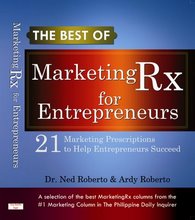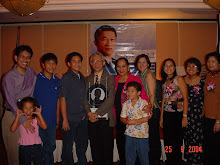MarketingRx for October 31/November 7, 2008:
By Dr Ned Roberto with Ardy Roberto
Q: We heard that you recently gave a talk on market segmentation and self-segmentation. We read your book on market segmentation and we’ve been helped by the segmentation approaches you introduced. But that book didn’t at all talk about self-segmentation.
Our news said that you told your audience that self-segmentation is more useful than market segmentation. What’s the difference between market segmentation and self-segmentation? How exactly is self-segmentation of more practical use?
Is this a new book of yours? If it is, where can we buy it? If not, please give us a brief explanation so we can benefit from it just as we gained better understanding of market segmentation from your book.
A: That recent talk isn’t that recent. It’s been some two months ago. Anyway let’s take up your questions. We’ve been asked those questions before and for quite a number of times.
The most instructive way to be clear about the difference between market segmentation and self-segmentation is to think of segmentation as a behavior. Our traditional practice of market segmentation is the marketer’s segmenting behavior. That’s basically your partitioning as a marketer of your total market into segments.
The partitioning may be by socio-economic classification. This is probably the most used segmenting variable. It’s a conventional practice in the shopping mall, restaurant and hospitality services business. The practice typically yields the Class AB (upper class) segment, Class C (middle class) segment, Class D (borderline poor) segment, and Class E (extreme poor) segment. In another occasion as in the apparel and food supplement categories, you may partition by age to come out with the young adult segment, the mature adult segment, and the post-mature adult segment. Others like to partition by gender (the male segment versus the female segment), or even by geographical residency.
The classic pHCare example
Self-segmentation is the consumer’s segmentation behavior. This was what the pHCare market launching team at Unilab found in the feminine wash market in year 2000. The total population of menstruating women at that time self-segmented themselves into the femwash user segment and the femwash non-user segment. According to AC Nielsen, the user segment made up 12% of the total menstruating population while the non-users were a large 82%.
The 82% non-users self-segmented into 3 sub-segments. There were about 50% out of this 82% who for their feminine hygiene needs used 2 substitutes, namely, soap or water. This 50% divided about equally between soap and water. The remaining 32% out of the 82% were the “true” femwash non-users whose reason for non-use was something like this: “Wala naman akong UTI. So di ko kailangan yan.” (I don’t have UTI. So I don’t need that.) This is the most difficult market segment to go after for converting into femwash usage.
The other 2, the soap-using segment and the water-using segment, are not as difficult a segment for conversion. This is because the first of these 2 is already unhappy with soap as a femwash substitute. Soap users say something like this: “It makes me dry and itchy down there.” So demonstrating that a femwash like pHCare won’t dry and won’t make its user feel itchy will lead to conversion in favor of pHCare. On the other hand, the water-using femwash prospects reason out this way: “Okay na ang tubig. Gastos pa yang feminine wash” (Water is okay. It’s extra expense to use feminine wash.) That’s a resolvable issue of affordable value-for-money pricing.
In population size, each of these 2 non-user segments is somewhat larger than the current18% femwash users. The consumers in the soap-using segment count to 20.5% prospective femwash users (= 25% x 82% non-users). That’s the same population size of consumers in the water-using segment.
Converting the soap users into becoming femwash users doubles (about a little bit more) the current femwash user market. Then bringing in the consumers in the water-using segment will more than triple that current femwash user market! As you can see, this is the argument in favor of taking advantage of consumer self-segmentation for its more practical business-growing benefits. As we often tell our seminar participants, the ultimate source for growing your business is a new user market segment. Find one and your double or even triple your business. Because the period of owning a new market segment has been getting shorter and shorter, you can appreciate why searching and locating a new user market segment has become ever more critical.
The AyalaLand example
Here’s another instructive case that reinforces this practical business-growing advantage of self-segmentation but with a different twist. This is the self-segmenting behaviour of home owners of AyalaLand.
Originally, the market segmentation that AyalaLand adopted was by the socio-eco classification of the upper-upper class, i.e., the Class A market. This real property company partitioned the Class A market into the Class AAA (triple A) segment, the Class AA (double A) segment and the Class A (single A) segment.
Over the years, as these market segments got “saturated,” research on home owners in these segments revealed that home owners here were self-segmenting themselves into a first repeat customers for another house and lot, and even as second repeat customers. At the life cycle stage of “Full Nesters 1” where the couple’s youngest kid is less than 6 years old, this Class A customer has been observed to be at its first peak repeat home buying. This is a potentially double-the-business opportunity.
Then at another life cycle stage of “Empty Nesters 1” where you now have older couples, with or without kids at home, but the household head is still working, a Class A customer in this stage has been recorded to be at its second peak repeat home owning. This time and in most cases, this customer buys for gift giving. One of the children is now getting married and what can be a more welcome wedding gift than a house for the newly wed. That’s potentially another double-the-business opportunity.
Where’s the difference in this case? Notice that the new market at each of the 2 peak repeat home buying opportunities comes from the same original customers. The same customer has segmented himself or herself to participate in 2 new market segments. That’s growing business from your already acquired customers. It’s not new customer acquisition as in the femwash case. That’s the most cost-effective sourcing of business growing.
So there you are. There’s hopefully the clear difference between market segmentation and self-segmentation, and the true practical business-growing advantage to navigating through this fast changing waters and times via customers’ self-segmentation.
Keep your questions coming. Send them to ardy.roberto@gmail.com or visit www.marketingrx.org . God bless!
Subscribe to:
Post Comments (Atom)










No comments:
Post a Comment